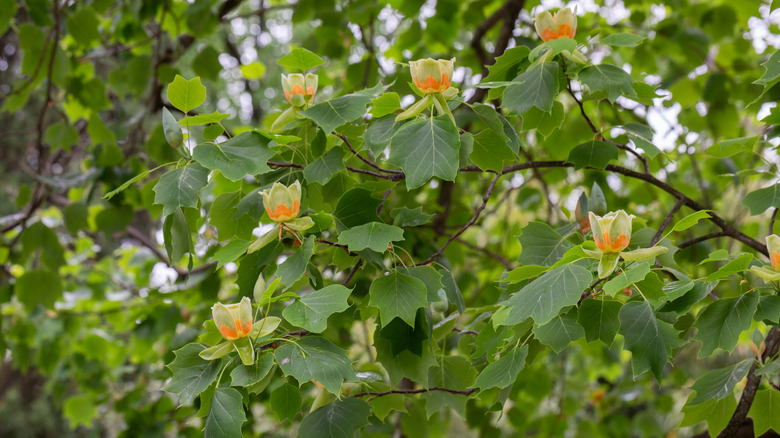This Tree Grows Fast, Blooms Bright, And May Be Perfect For Your Yard
Shade is an added value for any yard, but trees are valuable for far more than the cooling cover they provide. They reduce greenhouse gases, provide habitat for birds and animals, and improve mental health. A leafy canopy reduces rainwater runoff, lowering the chance of flooding. If you're looking to add a fast-growing tree with outstandingly bright blooms, you might want to consider a tulip poplar (Liriodendron tulipifera). This magnificent tree can grow 200 feet tall with a trunk diameter of up to 10 feet, but most only grow 90 to 120 feet tall with a 4-to-6-foot trunk. The canopy spreads 30 to 50 feet, providing large areas of welcoming shade. Young trees grow rapidly before maturing into one of the tallest native hardwoods in North America.
Native to Canada and the eastern and central U.S., tulip poplars derive their name from the large, fragrant green and orange flowers resembling tulips that bloom in the spring. The twigs have a spicy aroma when they're broken, and the large leaves turn yellow in the fall. Despite its name, the tulip poplar is not a true poplar but a member of the magnolia family. These outstanding trees provide many benefits for wildlife. Pollinators like butterflies, bees, and birds drink the nectar from the flowers. Swallowtail and viceroy butterflies spend their larval stage in the leaves, and squirrels and deer eat the flowers, seeds, and buds. If you decide to plant this tree, you can even watch hummingbirds flock to your yard.
Is Liriodendron tulipifera right for your yard?
Before you rush out to buy one of these, if you only have a small space, you might want to avoid this one because it can overwhelm a small backyard. However, tulip trees, with their wide canopy, striking flowers, and tall, straight trunk, are distinctive additions to the landscape. The trees, hardy in USDA zones 4 through 9, need rich, well-drained soil and will thrive in full sun. They prefer acidic soil but tolerate some alkalinity. If you're not sure about your soil type, send a sample to your county extension office or use a home test kit to measure the pH of your soil. When thinking about where to plant your tulip poplar, take the width of the canopy of a mature tree into consideration. The 'Arnold' cultivar, suitable for a smaller yard, only grows to about 60 feet tall and 20 feet wide.
Keep in mind that these trees are susceptible to a number of insect pests, such as aphids and scale. Aphid secretions, commonly known as honeydew, may result in a black, sooty, and unsightly mold. The trees are also prone to a few diseases, including powdery mildew and verticillium wilt. Because they grow rapidly, their branches can be weak and may drop in high winds or from an accumulation of ice or snow. The roots are shallow, so it's hard to grow other plants under the tree. As this tree is susceptible to heat, watch for yellowing leaves in the interior of its canopy — they're a sign of stress from drought. Tulip poplars are also prone to urban stresses like air pollution and can't tolerate salty soil or ocean spray.

